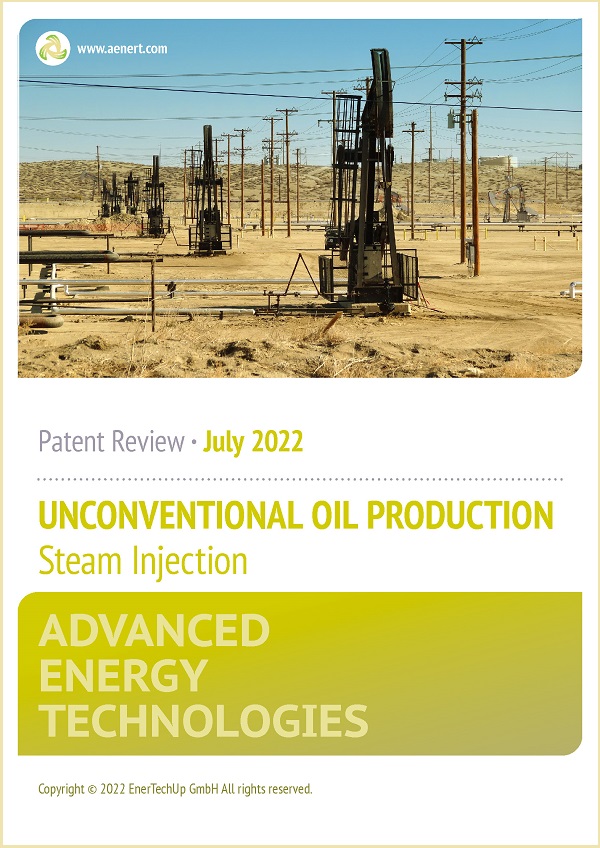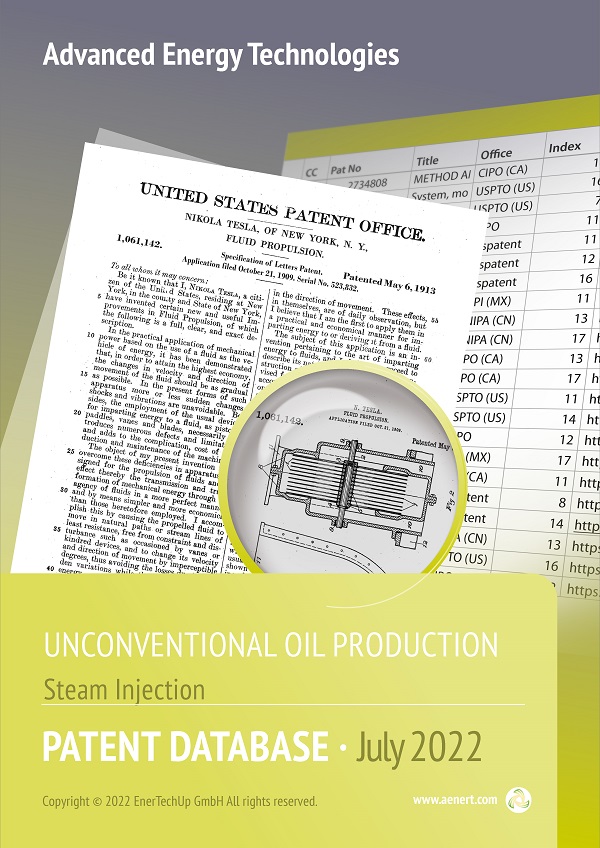UNCONVETIONAL OIL PRODUCTION. Steam Injection. Extended patent report. Aenert. July 2022

Summary
Methods of steam stimulation relating to thermal enhanced oil recovery became widely used for the production of various grades of unconventional oil, which is characterized primarily by high density and viscosity. On an industrial scale, these methods are prevalent in the extraction of bituminous oil (oil sands), extra heavy oil or kerogen oil (oil shale), having API gravity of less than 10o and viscosity often greater than 10 000 centipoise. The appearance of these grades of oil is substantially different from traditional oil, sometimes acquiring exotic forms. For instance, oil sands form a naturally occurring mixture of sand, water, clay, minerals and bitumen. Bitumen is a black and highly viscous liquid or semi-solid form of petroleum. Oil sand deposits can be found all over the world. Some of the most important oil sand deposits are located in Canada, Venezuela, the United States, and Russia. At the same time, the established reserves of natural bitumen in Canada alone exceed 160 billion barrels, which already is a huge energy resource. Presently, steam stimulation methods are also actively used in the production of lighter oil having API gravity of less than 25o.
Steam injection is one of the most common and widely-applied methods of thermal stimulation of high-viscosity and high-density oil reservoirs causing a significant reduction in the viscosity of the heavy oils. There are three major types of steam injection techniques – SAGD (Steam Assisted gravity drainage), CSS (Cyclic Steam Stimulation) and Steam flooding. In practice, the steam injection process is often supported by a combination of these technologies and the new techniques that are constantly being developed to improve them.
Steam Assisted Gravity Drainage (SAGD) is currently the most widely used in-situ recovery method. It requires the drilling of a top and a bottom well; steam is then injected continuously into the top well so that the bitumen becomes more fluid and flows to the lower well. The bitumen is then pumped to the surface.
Although steam-driven recovery methods are the most widely used and well proven EOR methods, there are a number of associated economic, technological, and ecological challenges. These include high greenhouse gas emissions, difficulties in operation and equipment maintenance, steam condensation, additional operational costs due to loss of energy and severe steam channeling. Therefore, the latest technological innovations in the field are aimed at optimization of the quality of the steam injection process and its generation equipment, while reducing the environmental impact. Equally important is the reduction of energy and water consumption, development of new equipment and materials, improvement of repair operations, and waste utilization. Also, hybrid methods of production, which combine methods of thermal stimulation and hydraulic fracturing, chemical stimulation, electromagnetic or acoustic stimulation, have been developed significantly.
A substantial part of effective technical solutions aimed at the development of these technologies is concentrated in patent documents registered with various patent offices. EnerTechUp company performed a systematic search of patent documents on this subject, prepared a unique patent database, and conducted a thorough statistical analysis of the patenting activity results.
All patent documents are labelled with specialized marking, allowing their grouping by semantic belonging, including sorting by patent offices, applicants, technological parameters, problems they are aiming to solve. Particularly, the data base allows lists of patent documents to be formed for the most popular technologies of steam treatment of underground formations, for instance, SAGD or Steam Flooding; and for elements of equipment involved into steam production and injection, waste utilization, etc. These original features of the database create unique opportunities for users of all levels to timely monitor the latest engineering achievements in the field of unconventional oil production, and to predict the development directions in the oil industry as a whole, or for individual regions and companies.
The database includes more than 13 thousand patent documents published in generally-accessible sources all over the world during 1987 and 2022. Statistical analysis for the 20-year period between 2002-2021 includes 4458 patents and 8562 patent applications. General methodology of patent database compilation and statistical evaluation used in this product can be found at aenert.com.
Key Highlights
Statistical analysis for the 20-year period between 2002-2021 includes:
Inventions: 13020
Offices: 53
Countries: 50
Applicants: 2342
Individual IPC subgroups: 2867
Total IPC subgroups assigned: 39050
In total, 13020 patent documents (4458 patents and 8562 patent applications) were found for the present review. The most active registration of patent applications took place in 2015-2019. The most popular patent offices with applicants were USPTO (the United States), CNIPA (China), and CIPO (Canada). Representatives of 50 countries around the world participated in the patenting process. The largest number of patents were granted to the residents of the United States, China, Canada and Russia. The largest number of patent applications in the last five years were filed by the residents of China, the United States, and Canada. The largest number of patents were issued to non-residents by CIPO (Canada), USPTO (the United States), IP Australia, and CNIPA (China).
The share of non-residents among applicants decreased significantly towards the end of the time period under consideration. The number of applications to total number of documents by year were 0.68-0.52 in 2017-2020. At the same time, the number of start applications to total number of applications by year was on a high level (0.40-0.44 in 2017- 2020). As of the end of 2021 more than 80% of patents were members of patent families (three and more patent documents). 34 patent families comprised more than 20 patent documents. Average patent pending time comprised 43-48 months in the last years.
In total, 2867 individual IPC subgroups that were assigned 39050 times and 2512 groups of identical unified indicators were identified in the patent database under consideration. Among IPC subgroups the most popular were E21B 43/24 (Obtaining fluids from wells using heat, e.g. steam injection), E21B 43/12 (Methods or apparatus for controlling the flow of the obtained fluid to or in wells), and E21B 43/16 (Enhanced recovery methods for obtaining hydrocarbons). Among patents and patent applications the popularity of IPC subgroups E21B 43/24, E21B 43/12, and E21B 34/06 (Valve arrangements in wells) has grown considerably. In patents, three and more different IPC sections simultaneously were assigned to 207 documents (more than 4.5%). The annual number of new IPC subgroups assigned to patent documents has decreased considerably in recent years. In patents and patent applications, the technological categories Heavy and extra heavy oil and Unspecified or general technologies were most often mentioned. In the majority of cases the authors indicated Low efficiency of primary production and High running costs of repair and replacement as the problems the technical solutions disclosed in the patents and patent applications were aiming to solve. In the vast majority of cases, the inventions were related to devices or methods.
The list of top 10 most productive applicants by the number of patents includes:
Halliburton Energy Services, Inc. (US)
Baker Hughes Incorporated (US)
ExxonMobil Upstream Research Company (US)
ConocoPhilips Company (US)
Shell Internationale Research Maatschappij B.V. (NL)
PetroChina Company Limited (CN)
Tatneft (RU)
Schlumberger Technology Corporation (US)
Sinopec China Petroleum & Chemical Corporation (CN)
Baker Hughes a Ge Company, LLC (US)
The concluding part of the analysis includes calculated data that allow the resulting patenting trends to be exposed and main conclusions to be drawn. Such diagrams as the relationship of the number of applications to the number of patents by year, the relationship of the number of single applications to total number by year, and others, are also presented here.
A free demo version of this database can be downloaded here:
The demo version presents the first hundred patent documents.
A brief analysis of statistical indicators is provided in a patent information bulletin, which can be downloaded here (license CC BY-SA 4.0):
Who needs this Extended Patent Report?
This Extended Patent Report (includes Database and Patent Review) serves as one of the variants to monitor advanced technical achievements in the specified industrial sector. The statistical data, rating evaluations and carefully selected patent documents provided in the Database can be of interest for inventors, engineers, researchers, students and educators, as well as for businessmen and investors, who in one way or another are concerned with the problems of the development of production of unconventional oil.
Disclaimer
The present patent database and patent review were prepared by EnerTechUp company and its partners. The extended patent report includes patent documents that were carefully collected from the publicly available sources and, according to the authors, to the greatest degree represent the latest innovations in the particular energy industry as of the date of the extended patent report preparation. Detailed information on the methodology of search and processing of patent documents is available at Advanced Energy Technologies (www.aenert.com). Considering the difficulties related to the compilation of lists of international patent documents, including those related to time frames, national and terminological barriers, as well as taking into consideration high labour intensity of collecting the required analytical information and performing its qualitative interpretation, the authors of the patent database and patent review cannot guarantee absolute completeness and accuracy of the represented materials and disclaim any responsibility for the use thereof. EnerTechUp represents this material “as is” and rejects any claims and liabilities arising from the use of data published therein, including, but not limited to: compensation for any type of financial damage, lost profit or compensation for moral injury. These stipulations also refer to employees, shareholders, agents and data suppliers of EnerTechUp.






